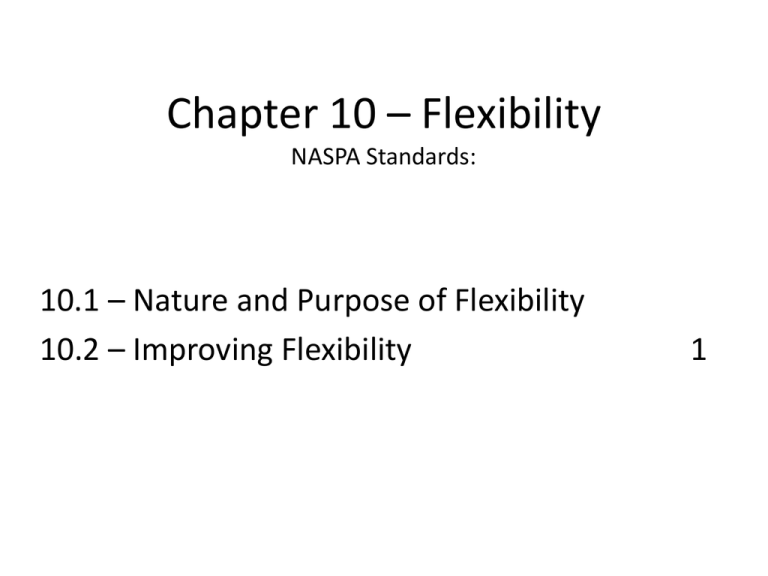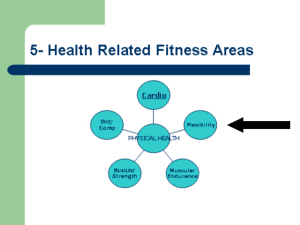Chapter 10 * Flexibility NASPA Standards
advertisement

Chapter 10 – Flexibility NASPA Standards: 10.1 – Nature and Purpose of Flexibility 10.2 – Improving Flexibility 1 10.1 – Nature and Purpose of Flexibility 4 Objectives: 1. Describe the characteristics of flexibility. 2. Explain how you benefit from good flexibility. 3. Explain why it is important to balance strength and flexibility exercises. 4. Explain how the fitness principles of overload, progression, and specificity apply to flexibility. 2 What is Flexibility? Flexibility is the ability to move your joints through a full range of motion. Two types of joints are: • Hinge joint – works like a hinge, allowing movement in only two directions. (knees/elbows) • Ball and socket joint – allows movement in all directions. (hip/shoulder) Range of motion is the amount of movement you can make in a joint. 3 Benefits of Good Flexibility Improved Function • Everyone needs a minimum amount of flexibility for everyday task. • Some people need more flexibility depending on the task they perform. Improved Health and Wellness • Stretching exercises help prevent injury, soreness, and have a beneficial effect on certain conditions. • Provide relief from leg cramps and shin splints • Improve posture • Prevent or relieve back pain • Reduce fatigue • Relieve stress 4 Characteristics of Flexibility Body Building and Flexibility – • Some people will never be able to score as well on flexibility tests as others, no matter how much they stretch. • Anatomical differences help determine what we can and cannot do. • Do not compare your fitness scores with others. Compare your scores with your own previous scores. 5 Characteristics continued…. Hypermobility – the ability to extend the knee, elbow, thumb, or wrist joint past a straight line, as if a joint could bend backward. • Often called “double jointed” • Inherited trait • People with hypermobility may be prone to injuries and the development of arthritis Joint Laxity – when a joint allows the bones to move in ways other than intended. • Occurs when the ligaments around the joint are overstretched. • Can lead to sprains, torn cartilage, and dislocations. • Ligaments cannot be strengthened by exercise, however strengthening the muscles around a joint can help reduce looseness. 6 Balancing Strength and Flexibility • Strength and flexibility should go together. • Only doing strength exercises can lead to a loss of normal range of motion. (muscle-bound) • If you only do flexibility exercises, then your joints may become susceptible to injury, because strong muscles are needed to reinforce the ligaments that hold the bones together. • A balanced exercise program includes both strength and flexibility exercises for all your muscles, so they can apply equal force on all sides of a joint. • Keeping muscles on opposite sides of a joint in balance helps them pull with equal force in all directions. 7 Fitness Principles and Flexibility Principle of overload - Principal of progression – • To increase flexibility you need to stretch or lengthen your muscles more than you normally do in daily activities. • You need additional force such as your own body weight, a partner, or a weight to assist in the stretch. • Gradually increase the intensity of exercise. (i.e. stretching further, longer, more reps) • Maintain your flexibility once you have reached your goal. 8 Fitness Principles continued… Principle of specificity – • Flexibility exercises improve ONLY the specific joints that you stretch. • Overall flexibility is achieved by stretching all of your body’s muscles. Maintaining flexibility – • Once you have reached your flexibility goal you must continue to move all your joints and muscles through this new improved range of motion on a regular basis. 9 10.1 Checking for Understanding 1. What are the characteristics of flexibility? 2. How do you benefit from good flexibility? 3. Why is it important to balance strength and flexibility exercises? 4. How do the fitness principles of overload, progression, and specificity apply to flexibility? 10.2 Improving Flexibility NASPE Standards: 3 Objectives – 1. Explain the difference between static stretching, PNF stretching, and ballistic stretching. 2. Describe the fitness target zones for static and ballistic exercise. 3. List the guidelines for doing flexibility exercises safely. 1







